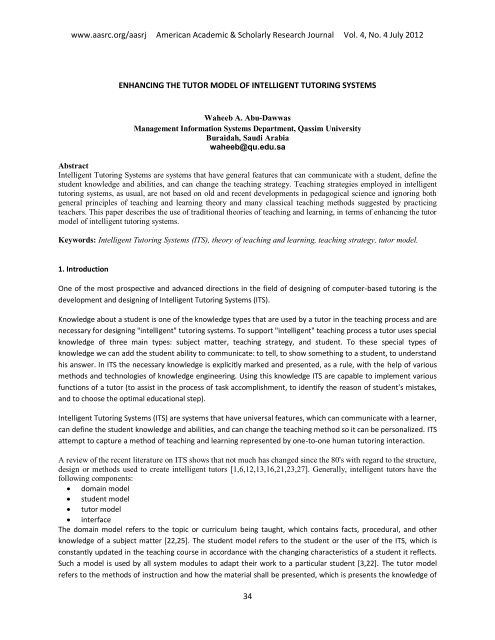E - American Academic & Scholarly Research Center
E - American Academic & Scholarly Research Center
E - American Academic & Scholarly Research Center
You also want an ePaper? Increase the reach of your titles
YUMPU automatically turns print PDFs into web optimized ePapers that Google loves.
www.aasrc.org/aasrj <strong>American</strong> <strong>Academic</strong> & <strong>Scholarly</strong> <strong>Research</strong> Journal Vol. 4, No. 4 July 2012<br />
ENHANCING THE TUTOR MODEL OF INTELLIGENT TUTORING SYSTEMS<br />
Waheeb A. Abu-Dawwas<br />
Management Information Systems Department, Qassim University<br />
Buraidah, Saudi Arabia<br />
waheeb@qu.edu.sa<br />
Abstract<br />
Intelligent Tutoring Systems are systems that have general features that can communicate with a student, define the<br />
student knowledge and abilities, and can change the teaching strategy. Teaching strategies employed in intelligent<br />
tutoring systems, as usual, are not based on old and recent developments in pedagogical science and ignoring both<br />
general principles of teaching and learning theory and many classical teaching methods suggested by practicing<br />
teachers. This paper describes the use of traditional theories of teaching and learning, in terms of enhancing the tutor<br />
model of intelligent tutoring systems.<br />
Keywords: Intelligent Tutoring Systems (ITS), theory of teaching and learning, teaching strategy, tutor model.<br />
1. Introduction<br />
One of the most prospective and advanced directions in the field of designing of computer-based tutoring is the<br />
development and designing of Intelligent Tutoring Systems (ITS).<br />
Knowledge about a student is one of the knowledge types that are used by a tutor in the teaching process and are<br />
necessary for designing "intelligent" tutoring systems. To support "intelligent" teaching process a tutor uses special<br />
knowledge of three main types: subject matter, teaching strategy, and student. To these special types of<br />
knowledge we can add the student ability to communicate: to tell, to show something to a student, to understand<br />
his answer. In ITS the necessary knowledge is explicitly marked and presented, as a rule, with the help of various<br />
methods and technologies of knowledge engineering. Using this knowledge ITS are capable to implement various<br />
functions of a tutor (to assist in the process of task accomplishment, to identify the reason of student’s mistakes,<br />
and to choose the optimal educational step).<br />
Intelligent Tutoring Systems (ITS) are systems that have universal features, which can communicate with a learner,<br />
can define the student knowledge and abilities, and can change the teaching method so it can be personalized. ITS<br />
attempt to capture a method of teaching and learning represented by one-to-one human tutoring interaction.<br />
A review of the recent literature on ITS shows that not much has changed since the 80's with regard to the structure,<br />
design or methods used to create intelligent tutors [1,6,12,13,16,21,23,27]. Generally, intelligent tutors have the<br />
following components:<br />
� domain model<br />
� student model<br />
� tutor model<br />
� interface<br />
The domain model refers to the topic or curriculum being taught, which contains facts, procedural, and other<br />
knowledge of a subject matter [22,25]. The student model refers to the student or the user of the ITS, which is<br />
constantly updated in the teaching course in accordance with the changing characteristics of a student it reflects.<br />
Such a model is used by all system modules to adapt their work to a particular student [3,22]. The tutor model<br />
refers to the methods of instruction and how the material shall be presented, which is presents the knowledge of<br />
34


